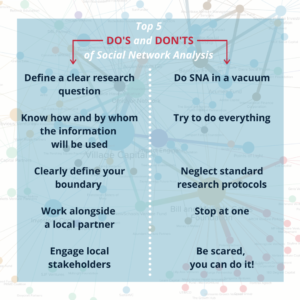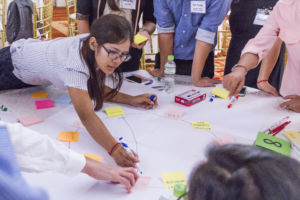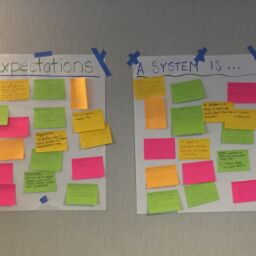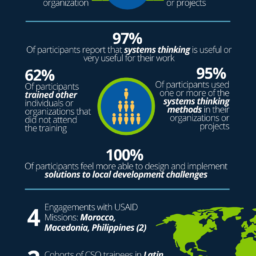By: Jenna White and Megan McDermott
Social Network Analysis (SNA) is a powerful tool for capturing complex relationships, and the structural characteristics of a network. Beyond identifying central actors within a network, it can provide measures of how tightly interconnected and how fragmented the network is. It can also provide identification of subgroups or clustering among a given population. All of this information can be used to elicit insights about strengths and weaknesses in communication, power structures, and network stability. Therefore, it’s not surprising that SNA has many applications in international development work.
Throughout the course of our USAID funded Local Systems Practice (LSP) activity, our consortia had the opportunity to work with USAID missions, local partners, and civil society organizations (CSOs) on multiple SNAs.
DO’s
- DO clearly articulate your research question.
SNA, like any research method is only helpful if you are clear about the question you are trying to answer. Having a clearly articulated research question ensures that a) SNA is the right method to use to answer your question b) resources are used efficiently and c) you gather all of the data required to answer your question. Gathering a bunchof data and then hoping it all adds up to something meaningful is a recipe for wasted resources. It is well worth taking the time prior to beginning an SNA to ensure you and your team agree on your research question before diving in.
2. DO know how and by whom the information will be used.
Audience matters. Know what your audience(s) needs from your SNA to ensure you capture the right data (not the most data). Understanding how this information will be used ensures that you capture the right actors and the types of relationships that are most relevant.
3. DO clearly define your boundary (start small).
When it comes to SNA, more is usually not better. The most successful (useful) SNAs we work on are those that have a tightly defined boundary, meaning the researcher has thought deeply about who comprises the network of interest and the characteristics of these actors. Regardless of whether you’re using a roster method or a snowball method, carefully thinking about the actors in your system upfront will save you significant time in the long run.
4. DO work alongside a local partner.
A local partner is essential. This partner ideally a) has knowledge of the system/issue you are researching b) has some basic technical skills (e.g. surveying) so you can transfer the methodology. Working with a local partner makes your research better and fosters locally-led development.
Note: Special thanks to our LSP partners Macedonian Center for International Cooperation (MCIC), Mobilising Rights Associates (MRA), and Alay sa Kapatid Foundation Inc. (AKAP) for being great partners and making our work better.
5. DO engage local stakeholders throughout the process.
All development efforts should include local constituents. SNA is no different. We have found it most helpful to hold focus group discussions with constituents prior to collecting data in order to check assumptions and verify our approach. Additionally, we encourage practitioners of SNA to consider how to present findings back to local stakeholders (keeping in mind any potential confidentiality concerns). Sharing and validating key findings with local stakeholders have been integral to our most successful SNAs.
DON’Ts
- DON’T do SNA in a vacuum.
SNA can answer many questions about the relationships among actors in a system. However, it cannot answer questions that begin with “why.” Consider adding some qualitative techniques to your research approach (focus group discussions, qualitative survey questions, etc.) to help you make sense of the data and contextualize it.
2. DON’T try to do everything.
Something about SNA tends to make people overly ambitious. It is very tempting to add in additional stakeholders to your roster, and additional questions to your survey instrument. However, more may lead to less. We find SNAs with clearly defined boundaries and a few well thought out questions lead to the most useful results and prevent the user from getting lost in a sea of data that usually does not lead to additional insights.
3. DON’T neglect standard research protocols.
The aim of all research in development must first be to do no harm. Don’t forget that SNA is research. And more often than not, the results of an SNA are not anonymized. Be sure to obtain IRB approval and follow standard research ethics protocols.
4. DON’T stop at one.
SNA is a snapshot in time. Repeating your SNA in the future can provide valuable insights into changes in the network over time. SNA can be valuable as an M&E tool for programs in a complex environment.

5. DON’T be scared, you can do it!
SNA can seem intimidating at first. However, with a little bit of training and some simple (and free) software you can be well on your way to conducting an SNA. Our LSP training program for CSOs trained participants on how to use SNA in only 4 days, and 75% of participants conducted an SNA within 6 months of the training.
To find out more about using SNA for international development, check out the LSP User’s Guide at www.localsystemspractice.org. If you’re in the DC area, consider signing up for one of our upcoming trainings.
More about LSP: LSP was a three-year USAID project that directly assisted multiple missions, local partners, and civil society organizations (CSOs) to design and adaptively manage systems-based programs in complex environments. Learn more about the project here.



